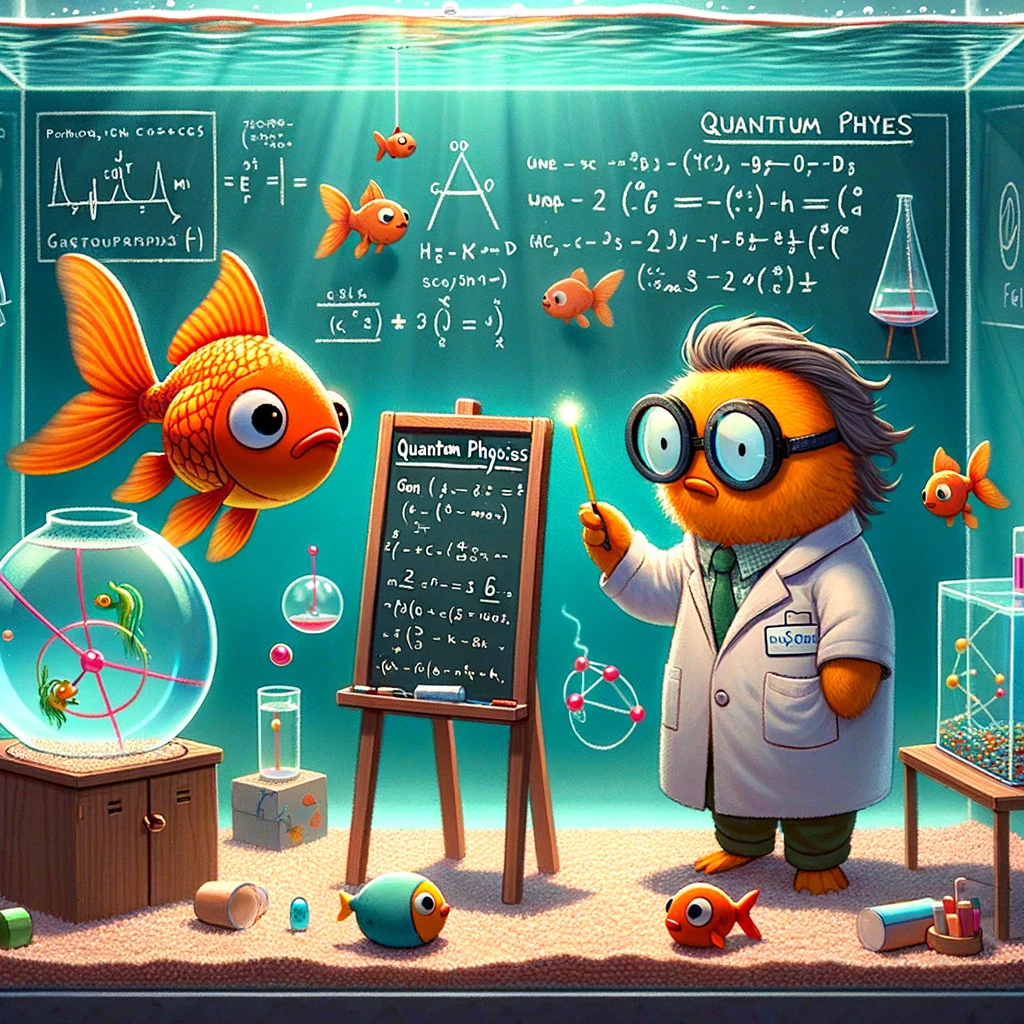Hey there, fellow fish enthusiasts and science lovers! Are you tired of your goldfish just swimming around aimlessly, not contributing anything to the field of quantum mechanics? Well, fear not, because I, Professor Fins McGee, am here to guide you through the process of transforming your finned friend into a bona fide quantum physicist. Get ready to dive into the fascinating world of subatomic particles, wave-particle duality, and Schrödinger’s fishbowl!
Why Quantum Physics?
- It’s the coolest branch of physics, hands down
- Your goldfish will be the talk of the aquarium
- Impress your friends at dinner parties with your quantum-savvy pet
- Finally understand what those eggheads on The Big Bang Theory are talking about
Prerequisites Before we begin, make sure your goldfish meets the following criteria:
- Has a basic understanding of classical physics (or at least knows how to swim in a straight line)
- Possesses an attention span longer than 3 seconds
- Is not easily distracted by shiny objects or fish flakes
- Has a genuine interest in unraveling the mysteries of the universe
If your goldfish ticks all these boxes, congratulations! You’re ready to embark on this quantum journey together.
Step 1: Setting Up the Classroom To create the perfect learning environment for your goldfish, you’ll need:
- A spacious fish tank (at least 20 gallons)
- A miniature chalkboard and chalk (waterproof, of course)
- A set of subatomic particle plushies (protons, neutrons, electrons)
- A tiny lab coat and goggles (safety first!)
Arrange the classroom elements in the tank, ensuring that the chalkboard is easily visible and the particle plushies are within fin’s reach. Don’t forget to snap a few photos for your Instagram – #GoldfishGenius #QuantumAquarium.
Step 2: Teaching the Basics Start with the fundamentals of quantum physics:
- The wave-particle duality: Explain to your goldfish that matter can behave as both a wave and a particle, using the classic double-slit experiment as an example. Demonstrate by shining a laser pointer through two narrow openings in a piece of cardboard placed against the tank. Watch as your goldfish marvels at the interference pattern created on the opposite wall!
- The uncertainty principle: Teach your goldfish about Heisenberg’s groundbreaking discovery – the more precisely you know a particle’s position, the less precisely you can know its momentum, and vice versa. Illustrate this concept by hiding fish treats in various locations around the tank and observing your goldfish’s frantic search. Explain that the act of observing affects the outcome!
- Quantum entanglement: Blow your goldfish’s mind with the idea that two particles can become entangled, meaning that their quantum states are linked regardless of the distance between them. Demonstrate this by placing two entangled fish treats in opposite corners of the tank and watch as your goldfish instinctively swims towards both simultaneously!
Remember to use plenty of visual aids, encouraging fin gestures, and the occasional fish pun to keep your scaly student engaged.
Step 3: Advanced Concepts Now that your goldfish has a solid grasp of the basics, it’s time to dive into some more complex topics:
- Schrödinger’s cat: Present the famous thought experiment involving a cat in a box with a vial of poison, a radioactive source, and a hammer. Explain how the cat is both alive and dead until the box is opened and the wave function collapses. Replace the cat with a fish treat to make it more relatable for your goldfish.
- Quantum tunneling: Teach your goldfish about the mind-bending phenomenon where a particle can pass through a potential barrier that it classically could not surmount. Set up a small obstacle course in the tank with barriers made of fish-safe materials and watch as your goldfish attempts to “tunnel” through them. Cheer enthusiastically when it succeeds!
- The Standard Model: Introduce your goldfish to the various elementary particles that make up the universe, using the subatomic particle plushies as visual aids. Arrange them in groups according to their properties (quarks, leptons, bosons) and explain how they interact through the fundamental forces.
Step 4: Practical Applications Show your goldfish how quantum physics is applied in real-world scenarios:
- Quantum computing: Explain how quantum computers harness the principles of superposition and entanglement to perform complex calculations far more efficiently than classical computers. Set up a miniature “quantum computer” in the tank using a series of interconnected fish tanks and watch as your goldfish swims through them, representing the flow of qubits.
- Quantum cryptography: Teach your goldfish about the unbreakable security offered by quantum key distribution, where any attempt to intercept the key would be instantly detectable. Demonstrate by sending secret messages to your goldfish using polarized light and a set of miniature polarizing filters.
- Quantum sensing: Highlight the incredible sensitivity of quantum sensors, which can detect the tiniest changes in magnetic fields, gravity, and temperature. Place a small magnet near the tank and observe how your goldfish’s behavior changes, illustrating its newfound quantum sensing abilities.
Step 5: Encouraging Independent Research
- Set up a miniature library in the corner of the tank, stocked with waterproof books on quantum physics, such as “The Feynman Lectures on Physics” and “Quantum Mechanics: The Theoretical Minimum.”
- Provide your goldfish with a waterproof tablet loaded with educational apps and games related to quantum physics, like “Schrödinger’s Cat Simulator” and “Particle Zoo Adventure.”
- Organize playdates with other quantum-savvy goldfish to encourage collaborative learning and the exchange of ideas. Who knows, maybe they’ll even come up with a revolutionary new theory!
Celebrating Your Goldfish’s Achievements Once your goldfish has mastered the art of quantum physics, it’s time to celebrate its incredible accomplishment:
- Throw a “Quantum Fiesta” in your goldfish’s honor, complete with subatomic particle-shaped decorations and a cake decorated with the Schrödinger equation.
- Submit your goldfish’s groundbreaking research to prestigious scientific journals, such as “Nature” or “Science.” Be prepared for a bit of skepticism from the editors, but remain confident in your goldfish’s abilities.
- Nominate your goldfish for the Nobel Prize in Physics. While the committee may be hesitant to award the prize to a fish, your goldfish’s contributions to the field of quantum physics are undeniable.
Conclusion Teaching quantum physics to your goldfish may seem like a daunting task, but with patience, persistence, and a healthy dose of humor, you can transform your finned friend into a veritable quantum prodigy. Remember, the journey of a thousand leagues begins with a single fin-flap. So, grab your miniature chalkboard, subatomic particle plushies, and a pinch of fish puns, and embark on this incredible adventure together. Who knows, maybe one day your goldfish will be the one giving lectures at the local aquarium on the intricacies of quantum entanglement!
And there you have it, folks – a comprehensive guide to teaching quantum physics to your goldfish. Now, if you’ll excuse me, I have to go set up a double-slit experiment in my fish tank. Until next time, keep swimming in the vast ocean of knowledge!
Recent Posts
Living with a roommate can be a rollercoaster of emotions, from the highs of late-night heart-to-hearts to the lows of finding their dirty socks in your cereal bowl. But what if your roommate is...
Well, well, well, look who decided to join the ranks of Etsy product photography royalty! In this uproariously hilarious blog post, we'll embark on a wild and wacky journey through the ins and outs...

